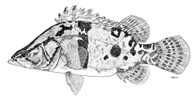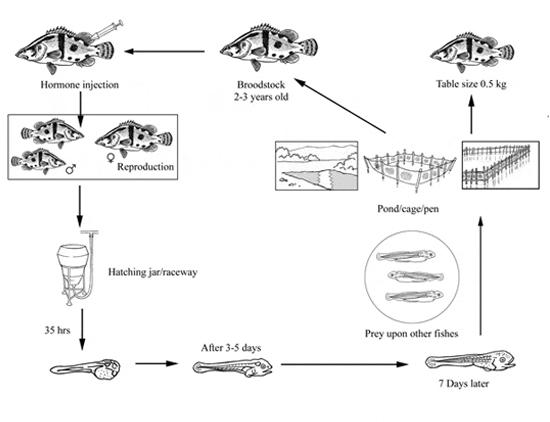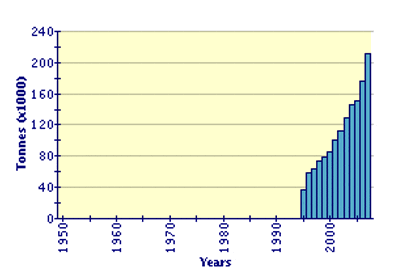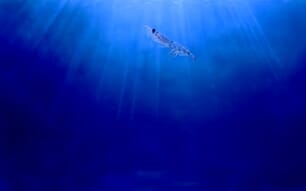Identity
Siniperca chuatsi (Basilewsky, 1855)
FAO Names: En - Mandarin fish, Fr - , Es -
Biological Features

Body compressed. Lower jaw protruding, upper jaw extending behind eyes. Mouth cavity along both upper and lower lips densely serrated with saw-like teeth. Lower jaw with 4-5 large sharp rays. Rear edge of gill cover has two flat sharp spines on each side. Scales round and small. Body brownish yellow, very shiny with irregularly placed coloured spots. Normally black or dark grey stripes from the lips through the eyes above the lateral but along the dorsal line. Well developed dorsal fins with mainly hard spines located anteriorly, and extended posteriorly with round tips. Pectoral, anal and tail fins round shaped. Three sharp spines anterior to both abdominal and anal fins.
Profile
Historical Background
Known from time immemorial in China, this fish became extremely popular in the Tang Dynasty (618-907 A.D.) and many poets eulogised about its colour and taste. However, the farming of mandarin fish did not begin until late in the 20th century. Experimental farming began in the 1950s when wild-caught seeds were used; farmers found that it was an excellent species for culture. Later some Chinese farms conducted research on seed production, but the fish only survived for about 10-15 days. Finally, in 1975, the Suzhou Municipal Farm, Jiangsu Province, produced 482 mandarin fishes reaching an average size of 375 g each through induced breeding. From then onwards, the farming of this species under controlled conditions has become more and more popular.
Mandarin fish are popular in north-eastern Asian countries, being found naturally in China, DPR Korea, the Korean Republic, Japan, Russia and Viet Nam. 11 species in three genera are known but only nine species are found in China. The most popular genus (Siniperca) has seven species, of which the farmed species (Siniperca chuatsi) is the most common.
Main Producer Countries

Habitat and biology
Mandarin fish dwell in lakes and river systems, preferring clean water and to hide amongst the stones, tree roots and densely grown aquatic grasses at the bottom. When the temperature drops to 1-5 °C in the winter, the fish stay calm in deep water for over-wintering, but when it rises above 15 °C, the fish begin to actively search for food. Mandarin fish are generally nocturnal, feeding at night but staying quiet in sheltered areas under natural conditions in the daytime. However, in controlled conditions, when being farmed, they will take food even in the daytime. Mandarin fish have a broad temperature tolerance range, which is why they are found in most parts of China.
Mandarin fish are carnivorous, feeding on live fish, shrimps and other aquatic animals that are smaller than themselves, particularly fish. Mandarin fish will not take static aquatic animals, even it they are immediately adjacent, but as soon as the targets begin to move, they swiftly catch them without hesitation. Mandarin fish begin to consume fish fry of other species at four-five days old. In the wild they prefer to take Wuchang fish (Megalobrama amphylocephalus) at first because of its body shape, but all spindle-like fish are vulnerable. When mandarin fish are kept under controlled conditions cannibalism occurs unless sufficient food is provided. Mandarin fish grow rapidly, reaching 400-600 g within one year and 1-1.5 kg in the second year. After this, their growth rate declines, both in weight and length, and females grow faster than the males in the third year.
Mandarin fish do not reproduce until the temperature exceeds 21 °C, the optimum temperature being 26-30 °C. Due to the different climatic conditions from the south to the north of China, the breeding season varies a great deal. In the south it occurs between March and August, while in the central part it occurs between May and August, June and July being the most active period. During the breeding season spawners gather densely at the river bend or confluence where there is an enhanced water current. Spawning takes place in a flowing water environment, only at night; normally this lasts for three-six hours but very occasionally may last 24 hours. Females mature in two years at a minimal body weight of 160-250 g (21 cm), while males take only one year, the smallest being about 80 g (16 cm). Generally, fecundity is 30 000-200 000 eggs/fish, depending on the size of the female. Mandarin eggs are 1.2-1.4 mm in size and semi-pelagic in flowing water, but sink in stagnant water.
Production
Production Cycle

Production Systems
The major farming systems for mandarin fish are pond culture, cage culture and pen culture. Both monoculture and polyculture is carried out in ponds, while cage and pen culture is used in open waters such as reservoirs, lakes and even rivers.
Seed Supply
Since natural seed availability has become limited as a result of intensive capture, farmers have had to find a way to enhance the supply by induced breeding.
Brooders are collected and selected from both open waters and farmed fish. They need to be healthy, active, and large; the use of two-three year-old fish at 1-2 kg is normal but 0.5 kg males and 0.75 kg females are also effective for breeding. Extra care is taken to condition broodfish well, from 40-60 days prior to spawning. The hormones used for induced breeding are usually PG, HCG, and LRH-a, either singly or in combination. Dosages for females are shown in the following table (males only receive half these amounts):
| Single hormone | 14-16 mg | - | - | 0.8-1.6 mg | -- | 10-15 mg | -- |
| Combined hormones (I) | 1.5-2 mg | 500-800 IU | - | - | 20 µ | 2.5 mg | 200 µ |
| Combined hormones (II) | - | 500 IU | 50 µ | - | - | - | - |
* The interval between the first and the second injection is about eight hours.
Hatchery production
After being injected the brooders are placed in spawning tanks. Natural spawning or artificial insemination is used. Eggs hatch in 23-30 hours, depending on water temperature and hatching facilities. Careful hatchery management to ensure suitable water flow is essential. Water temperature should be kept relatively stable; at 25-29 °C it takes 20-30 hours for hatching to occur but can take 50-60 hours if temperatures are lower than this range.
Rearing fry
Newly-hatched mandarin fish are only 4 mm and are fragile; after 50-60 hours, body length increases to 5 mm and they start to feed; without feed, cannibalism occurs. Fry are fed at approximately two-three live fish fry per mandarin fish per day at first; silver carp, bighead, grass carp, Wuchang fish or tilapia fry are used. By day four the mandarin fish fry will consume four-five live fish fry per day.
Nursery
The nursery phase may be conducted in flowing or static water.
Flowing water nursery
The stocking rate is 5 000-10 000 fish/m³, depending on hatchling size; 50-100 m³ concrete tanks, which may be square or rectangular, are used. After five-seven days, the fry are transferred and restocked into earthen ponds. Feeding should cease 10-12 hours prior to transfer to prevent physical injuries.
Standing water nursery
Preferably, tank size is 4 x 6 x 0.8 m and the stocking rate is 7 000/m³. Branches are placed on the bottom of the tank to provide shelter for feeding activities.
Pond nursery
Farmers prefer to rear the fry further in static water earthen ponds after they reach 1.5 cm, which takes about 10-15 days in the tanks. The minimal pond size is 1 000 m², with a water depth of 0.5-1 m. The pond is prepared with a sandy, low silt bottom.
After 20-25 days in the nursery pond, the fish reach 3-5 cm in body length; this is the correct time to transfer them into the fingerling rearing facilities. It is important to grade the fish every week; otherwise the fast growing individuals will prey upon smaller fish.
Fingerling production
Many farmers nowadays do not use a separate fingerling production phase, preferring to stock 3-5 cm fish fingerlings directly into the grow-out ponds. However, other farmers do use an intensive fingerling production phase. In these cases, the stocking density is 3-4.5/m² and the feeding rate is 5-10 percent of the standing crop. The fingerlings may be reared either in monoculture or in polyculture with carps, or in cages. Pond farming is the most efficient method; ponds of 2 000-4 000 m² and 1.5 m deep are utilized. Survival rates of 50-70 percent are common but 90 percent is achievable.
Ongrowing Techniques
Several farming systems for mandarin fish are used in China; all are very successful in practice.
Pond farming
Pond farming is one of the most popular methods used, either in monoculture or polyculture.
Monoculture is conducted either in earthen ponds or concrete tanks. Earthen ponds are typically 0.7-1.0 ha in area and 2.5 m deep, while the concrete tanks are half that area and 1.5-2.0 m deep. The pond bottom is rather compact and sandy and some branches are usually provided as shelters. Since mandarin fish does not need fertile water, slightly flowing water is best. The average stocking quantity is 50-80/100 m² of 3 cm fingerlings. Sufficient food supply (5-10 percent of biomass) is essential to prevent cannibalism. Feed (new live fish) is provided every five days, roughly about two-three days before all the feed previously supplied would be consumed; this is because the live fish provided as food also grow in the pond and become too large for the mandarin fish to consume.
The polyculture system is also applied in earthen or concrete ponds. The stocking rate is 40-70/100 m² of 3 cm mandarin fry. In this system, there is normally no additional feed supply; the stocking of secondary fish, such as crucian carp and/or tilapia, provides sufficient live feed for the mandarin fish. The stocking density for crucian carp is 1/m² and for tilapia is 30-50/100 m². Fry and fingerlings of silver carp, bighead and grass carp are also good live feeds for mandarin fish, being cheap and readily available resources.
Cage culture
Net cages, placed in unpolluted areas with high dissolved oxygen content, are supported by and fastened to bamboo poles. Cage sizes depend upon the open water space available and the managerial skills of the farmers. Generally they are between 50-100 m² and are placed 50 cm above the lake bottom. Stocking rates are typically 20-40/m² and the feeding regime is similar to that in pond culture.
Pen culture
Pens, situated in the shallow parts of lakes or reservoirs, range in size from 0.2 to 10 ha. Smaller pens are preferred for easy operation and management, but the capital investment per unit is higher. The stocking rate used is 1 500-2 000/ha of 3-5 cm fish. Pen culture is generally extensive; feeding normally depends on the wild fish present in the area but supplemental (live) feed is given if available.
Feed Supply
No commercial artificial feeds for mandarin fish are yet available.
Harvesting Techniques
Having started to breed when temperatures reach 21 °C (late March or early April in southern China) and taken a further 20-25 days to reach the 3-5 cm stocking size for on-growing, by late November or early December the on-growing facilities are ready for harvesting. By this time mandarin fish will have reached an average of 450-600 g. Pond production can reach 6 750-7 500 kg/ha in monoculture or 3 000-4 500 kg/ha in polyculture. Harvesting is generally done once a year. The fish are netted out when the pond is completely drained; the water level is reduced first, to simplify netting. However, selective harvests are also conducted prior to the final harvest, generally starting in September when the fish first reach a minimal market size. In the cage culture of mandarin fish, harvesting is carried out by lifting the corners of the cages, following which scoop nets are used to catch the fish. Harvesting in pen culture varies and may involve trawling nets, gill nets and traps.
Handling and Processing
Unlike the supply of carp, the availability of farmed mandarin fish is limited on a national scale. With such relatively small quantities available, mandarin fish are therefore sold fresh or live; as yet, there is no processing, not even salting.
Production Costs
Mandarin fish are highly valued and non-traditional. The price of the fish in the market is about 4-10 times higher than the traditional carp; therefore there is currently plenty of opportunity for farmers to make a profit in this industry. However, the costs of the production will certainly rise. Production costs are mostly attributable to feed (live fish, sometimes prawns) which accounts for 40-45 percent; pond rental, chemicals, labour, water and power comprises the rest. Total production costs ranged between USD 2.2-2.8/kg in 2004 and early 2005.
Diseases and Control Measures
In some cases antibiotics and other pharmaceuticals have been used in treatment but their inclusion in this table does not imply an FAO recommendation.
| Disease | Agent | Type | Syndrome | Measures |
|---|---|---|---|---|
| White skin disease | Pseudomonas dermoalba | Bacterium | Initially, white spots appear on base of dorsal fin & caudal peduncle & rapidly expand in all directions; body colour around dorsal, anal & tail fins becomes white; finally, diseased fish lose balance & swim with head down & tail vertical; fingerlings of 3-10 cm are the most vulnerable to attack | Careful handling to reduce physical injuries; timely food supply to prevent cannibalistic attacks; bleaching powder solution applied at 1g/m3 in ponds; Chinese gall (herbs) applied to ponds at 1.5 g/m3; bathe diseased fish in aureomycin at 12.5 g/m3 or terramycin at 25 g/m3 for half an hour |
| Gill rot disease | Myxococcus piscicola | Bacterium | Gill filaments turn white & rotten & fill with silt & mucus; gill membranes become transparent; diseased fish swim slowly alone; body becomes dark in colour & fish become emaciated | Regular pond disinfection by liming; bathe diseased fish in 10 g/m3 bleach; apply bleaching power to ponds at 1 g/m3 twice within 24 hours |
| Trichodina disease | Trichodina spp. | Protozoan | Parasites found on skin or gills; fish become emaciated & swim slowly alone | Thorough pond disinfection; bathe fish in 8 ppm solution of copper sulphate for 15-20 minutes; soak Chinaberry (Melia azedarach) in pond for 7-10 days at 225 kg/ha for 3-4 consecutive times; bathe diseased fish in 150 ppm formalin for 10 minutes, or 2 percent NaCl for 15 minutes, or 3 percent NaCl for 5 minutes |
| Cryptobia disease | Cryptobia branchialis | Protozoan | Parasites found on skin or gills; gill filaments typically red with heavy mucus; breathing difficulties; depressed appetite; swim slowly alone | Thorough pond disinfection; bathe fish in 8.0 ppm solution of copper sulphate for 15-20 minutes; soak Chinaberry (Melia azedarach) in pond for 7-10 days at 225 kg/ha for 3-4 consecutive times; bathe diseased fish in 150 ppm formalin for 10 minutes, or 2 percent NaCl for 15 minutes, or 3 percent NaCl for 5 minutes |
| Ichthyophthiriosis; White spot disease | Ichthyophthirius multifilis | Ciliate | Body surface swollen & congested with parasites; white spots; vacuoles appear on parts of body; heavy mucus; slow swimming along | Transfer diseased fish to newly disinfected ponds; bathe |
Suppliers of pathology expertise
The following institutes can provide expertise in this topic:
- Institute of Hydrobiology, CAS, 7 Donghu South Road, Wuhan City, Hubei Province, P.R. China 430072.
- Shanghai Fisheries University, 334 Jungong Road, Shanghai, P.R. China 200090.
- Pearl River Fisheries Research Institute, CAFS, Xilang, Fangcun District, Guangzhou City, China 510380.
- Freshwater Fisheries Research Centre, CAFS, 9 Shanshui East Road, Wuxi, Jiangsu Province, China 214081.
- Zhejiang Provincial Freshwater Fisheries Research Institute, Nanmenwei, Huzhou City, Zhejiang Province, 313001 China.
- Research Institute for Aquaculture No.1, Dinh Bang, Tien Son, Bac Ninh, Hanoi, Viet Nam.
- Jinhae Inland Fisheries Research Institute, 577-1, Yeogwa-dong, Jinhai-si, Kyeongsangnam-do, Republic of Korea.
Statistics
Production Statistics

(FAO Fishery Statistic)
IStatistics for farmed production of mandarin fish only appeared in the mid-1990s; previously, only small and accidental catches from open waters were recorded. Farming, solely confined to China, had been initiated in the late 1980s and reached a considerable scale in the 1990s. Chinese statistics show that by 1993 the national production had reached over 17 500 tonnes. Farmed production of mandarin fish first appeared in FAO statistics in 1995 (37 000 tonnes); expansion was significant and production from China was reported to be almost 150 000 tonnes by 2003. However, mandarin fish production is highly regionalized. Guangdong Province in the south takes a strong lead as the major producing area. Grow-out farming accounted for over 84 700 tonnes in this province in 2004. The reason for high production in this province is attributable to the availability of live food, which is two months longer than elsewhere due to the climatic conditions.
Other countries, such as DPR Korea, Republic of Korea, Japan, Russian Federation and Viet Nam, produce relatively tiny quantities of mandarin fish and none have reported this in statistical returns to FAO so far. However, informal reports indicate that production in the Republic of Korea had reached 50 tonnes/yr by 2004.
Market and Trade
Mandarin fish normally appears in the market alive, having been transported from the farms either by farmers themselves or by middlemen. The fish is kept alive in a container and sold fresh. This species is not yet processed in any form, or even salted.
The price of mandarin fish is seasonal and also depends on supply. At the end of the year when harvesting takes place there is plenty available and the price drops. However, at the time of the lunar New Year (between late January and early February), prices rise significantly because of the demand. Most producers and middlemen will empty their stocks at this time and prepare for the production of the following year. From early March to late July, the supply decreases and the price are at their highest. Generally the value of mandarin fish is ten times greater than that of silver carp. At the end of the year retail prices generally reach USD 4.3-6.1/kg; when there are supply shortages, they can rise to USD 6.5-7.3/kg.
The trading of mandarin fish is quite active, but only within domestic markets; however, the live fish that is transported from Guangdong Province to Hong Kong SAR includes this species (no specific data available) as an important quality fish. Markets north of Guangdong Province accept a good quantity of this fish, farmers filling the supply gaps in local markets.
Status and Trends
Mandarin fish farming, with more than a decade of development by 2003, had reached a production of 150 000 tonnes but about two thirds of this was produced in one province, Guangdong. It has become one of the important aquaculture species and there is considerable expertise in its culture. The fish is acknowledged as the 'freshwater grouper' and has a good taste, is easy to farm with a high output, and has a good market, producing a profitable return. The profit is about 4-6 times greater than traditional farming systems; moreover, it is less labour-intensive.
Better-off farmers with good managerial knowledge have been enthusiastic to work on this fish. However, while the output of farmed mandarin fish has steadily increased in China, its expansion has not been so fast as originally expected. This is because production costs are high, with many individual farmers finding it difficult to cope with the rental cost of land, the costs of live feed, and the risks of farm management.
Mandarin fish are strongly resistant to cold climatic conditions since their native environment is temperate. At lower temperatures, the fish very successfully dwell in open waters. Owing to their characteristics, research has been conducted on gene transfer to tropical fish such as tilapia, which will bring tremendous profits to farmers in temperate areas when success has been achieved.
Mandarin fish have a good taste, few inter-muscular bones, and are safe for human consumption. They are also recommended for international markets, in ready-made processed products such as fish balls and fish slices. However, it will take time for consumers to adapt since this fish is currently only known in domestic markets; it has not yet been exposed to international markets.
Main Issues
Some consumers in China can afford to buy mandarin fish and consumption of mandarin fish is now quite common; this species has already found a niche in farming system studies. However, the fish is a carnivore, and when farmed is mainly fed with spindle-shaped live fish. Therefore, the development of artificial feeds for mandarin fish is critically important. The feed will not only need a sufficient level of nutrients but be acceptable to the fish; thus feeding behaviour will also need to be studied. Such developments are important, so that farmers can drop 'feeding fish with fish' regimes.
Responsible Aquaculture Practices
Studies on feed development that respond to its feeding behaviour are necessary. Since the fish is welcomed in the market and has a high value, its farming is expected to increase. Success in artificial feed development will help resource-poor areas.
Mandarin fish is a highly localized species in the region. In domesticating and transferring mandarin fish to other areas, careful studies are needed to prevent negative impacts on the environment and on biodiversity. Maintaining gene purity is also a research priority. Until there is a clear understanding of the impact on biodiversity conservation, merely economic transfer is not recommended.
In general, mandarin fish farming should appropriately follow the tenets of the FAO Code of Conduct for Responsible Fisheries and the FAO Technical Guidelines for Responsible Fisheries.
November 2010




